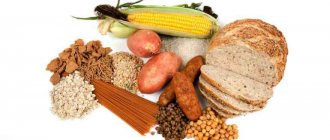Tomatoes
The tomato is native to South America. It reached us only after the discovery of this continent, and only in the form of decoration. Its bright red berries have long been considered poisonous in Europe. This point of view did not appear out of nowhere - the leaves and stems of tomatoes contain poisonous solanine, which is also present in green fruits. It is destroyed during ripening and during heat treatment.
This vegetable is not only rich in vitamins C and E, but also iron and potassium. It also contains a valuable dye - lycopene, which is a powerful antioxidant with a strong anti-cancer effect. Tomatoes are low in calories and high in fiber, making them ideal for weight loss. Its juice, applied topically, helps lighten age spots on the skin and soften the effects of changes after acne.
What vegetables normalize digestion?
The healthiest ingredients in your diet for improving digestion are those that are richest in fiber. It normalizes digestive processes in the body, relieves constipation and improves food processing. It is worth adding that while eating healthy vegetables, you need to drink a lot to avoid flatulence. You can find out which plant foods are most beneficial for intestinal function from the list:
- avocado;
- spinach;
- beet tops;
- turnip;
- broccoli;
- black radish;
- kohlrabi;
- zucchini;
- radish;
- cucumber;
- celery.
Of course, all vegetables are healthy, each of them contains a huge amount of useful substances. They give vegetables various properties that can be used for the health of the body. Knowing the chemical composition of each vegetable, you can easily do without medications and improve the functioning of many organs.
Onion
Onions contain many vitamins and minerals, but most of all they contain vitamin C, B, PP, fluorine, magnesium and iron.
Onions are a natural “antibiotic” that can improve health and support it during colds. The antibacterial properties of onions lie in the presence of phytoncides in it, which act as a barrier to the penetration of pathogenic microbes into the body.
A simple way to combat viral diseases is to inhale the smell of onions from a cut slice several times a day. Then the essential oils of onion will penetrate the nasopharynx, neutralizing bacteria and creating an antibacterial effect.
Onions also stimulate digestion, improve appetite, speed up metabolism, lower bad cholesterol levels, and improve blood circulation.
Which vegetables have a beneficial effect on the skin?
What fruits have a rejuvenating, tightening, antiseptic effect is influenced by the content in them:
- antioxidants (spinach, tomato, bell pepper, pumpkin);
- beta-carotene (pumpkin, carrots);
- phosphorus (cucumbers, cabbage);
- selenium (lettuce, spinach, dill, radish, Jerusalem artichoke);
- fatty acids (avocado, vegetable oils);
- iron (chard, broccoli, green peas, spinach, green beans, green turnips);
- zinc (cilantro, garlic, celery root, asparagus, pumpkin, beets).
Based on what skin problems you have, you need to complete the list of necessary vegetables with the appropriate products: beta-carotene and antioxidants are indispensable for dry skin; iron, phosphorus and fatty acids even out complexion and increase elasticity; Selenium promotes the production of collagen, zinc heals wounds, its properties are useful for inflamed and acne-affected skin.
bell pepper
The leader in the abundance of vitamin C among vegetables is bell pepper. The vegetable also contains iron and B vitamins. Bell pepper improves the condition of hair and nails, and also strengthens the immune system.
The most natural pepper can be bought at the end of the summer season.
It should be weighty, with smooth skin and shine. The color of the pepper should be uniform, without any spots. The stalk of a good pepper is green and not dry. Peppers purchased in the summer can be frozen for use in the winter.
At the same time, they will retain useful components.
White cabbage
This is one of the oldest plants consumed by humans. By the end of the Middle Ages, cabbage was the most popular vegetable on our continent. It is not only nutritious, but also has anti-inflammatory properties. Contains antioxidants that effectively prevent the formation of free radicals. A valuable component of this vegetable is sulforaphane, which also has antitumor properties. It is able to kill bacteria responsible for causing stomach ulcers. Cabbage is also a source of vitamins C and K, beta-carotene and calcium.
Author: Full-Fit
Peas
Since it is rich in fiber, it perfectly supports the health of the digestive system. True, it contains a large amount of carbohydrates, so consuming this product in large quantities may increase blood glucose levels.
A dish of cooked green peas contains 9 grams of essential fiber, 9 grams of protein, as well as vitamins A, C and K, riboflavin, thiamine, niacin and folate.
Garlic
Just like onions, garlic is a plant concentrate of beneficial vitamins and minerals, the most unique of which are allicin and phytoncides.
Garlic has antiviral properties due to the presence of allicin, an element that has a bactericidal effect. This is why garlic is so effective during colds, because allicin is a natural enemy of viruses.
Eating garlic can lower blood cholesterol levels - allicin is also responsible for this.
Garlic also has antibacterial properties. It prevents the spread of pathogenic bacteria in the body, reduces the likelihood of proliferation of yeast, staphylococcus, dysentery pathogens, etc.
Garlic is the best aphrodisiac for men. Consumption of garlic improves potency, bringing blood circulation in the genital organ back to normal, because its normal functioning depends on the unhindered flow of blood into the cavernous bodies of the penis, and also qualitatively improves the composition of sperm and increases sperm activity.
Eggplant
Due to the content of fiber, potassium and vitamin C in the vegetable, the functioning of the heart improves, the amount of bad cholesterol decreases and weight is normalized.
Eggplant peel contains antioxidants. They promote rapid removal of toxins from the body, improve memory and brain function.
Rich in healthy ingredients, the eggplant should be firm, with smooth and shiny skin. The stalk should be green and not dry.
Broccoli
This cabbage variety comes from Cyprus. Broccoli has been widely used since the times of ancient Greece and Rome. Currently, broccoli is considered one of the most valuable vegetables for our health. It contains antioxidants with a strong anti-cancer effect, beta-carotene, vitamin C and substances that stimulate tissue and cell regeneration, the production of red blood cells and DNA synthesis.
Broccoli also contains a lot of calcium and coenzyme Q10, which increases the body's immunity. A diet rich in broccoli is known to be extremely beneficial for women. It helps prevent depression, relieves symptoms caused by tension before the onset of menstruation, and also protects against breast, ovarian and cervical cancer.
Tomatoes
Tomatoes have a low amount of sodium and high potassium content, so they will help normalize blood pressure.
This proportion of components reduces the risk of developing heart and vascular diseases. Tomatoes will increase glucose levels, so they are recommended for diabetics and those who eat little sweets.
Due to their collagen content, tomatoes delay the aging process of the skin. The fiber present in them improves intestinal function and helps with constipation.
The positive effect of tomatoes will be achieved if they are not salted.
Tomatoes are capable of accumulating nitrates. Therefore, when choosing this vegetable, you need to look not only at its appearance, but also know in what environment they grew. It is especially problematic to find healthy tomatoes in winter.
TOP 10 healthiest leafy vegetables
Here is a list of leafy vegetables that are very healthy. In addition, they do not require special conditions and can be grown at home. This is another advantage of them if you don’t know what to do during quarantine.
Spinach
Spinach is one of the most accessible green vegetables. The benefit of spinach lies in its high content of vitamin C and A, protein, potassium, and iron. These beneficial substances help the skin to be elastic and healthy, bones to be strong, hair and nails to be healthy.
Spinach is used in preparing various dishes:
- added to cocktails;
- cook green soups;
- eaten in salads;
- used as a filling for pies.
We recommend freezing spinach for the winter; it’s easy to do. In winter it can be used in first and second courses.
Growing this plant is not difficult. It is unpretentious and grows in greenhouses and open ground. If you don’t have your own garden plot, you can get a harvest if you plant spinach even at home in pots or containers.
Spinach is a popular leaf vegetable that is used raw and also cooked. Rich in folic acid, has an anti-inflammatory effect, a powerful antioxidant.
Salad
Various varieties of lettuce are a good helper for those who are on a diet and care about their health. The salad is low in calories, but has a lot of useful substances: vitamins, omega-3 acids, phosphorus. The benefits of salad are that it:
- stabilizes sugar levels, preventing them from rising;
- maintains hemoglobin in the blood;
- helps the skin to be clean;
- increases immunity.
Traditionally, various salads are prepared from the leaves of this vegetable. You can also make green creamy soups or add the leaves to smoothies.
Some varieties of lettuce can be grown at home even in winter. For example, Baby lettuce is an excellent variety for year-round cultivation on window sills or insulated loggias. If you have a summer cottage, then by sowing seeds of various varieties of lettuce in open ground, you can be sure that you will get a bountiful harvest.
A variety of salad varieties allows you to choose one or several that suit your taste. This leafy vegetable is rich in vitamins B and C, as well as minerals such as potassium, phosphorus, and magnesium. This complex strengthens nails, makes hair healthier, and counteracts vision impairment.
Cabbage
Leafy vegetables include various varieties of cabbage, for example, cabbage, savoy, Brussels sprouts, broccoli, cauliflower.
A significant benefit of cabbage lies in the high content of vitamins such as C, K, A, potassium, calcium and folic acid.
It probably doesn’t make sense to talk about cabbage recipes - every housewife knows them well. We will only note the cooking methods. Cabbage leaves:
- consumed raw in salads;
- stew;
- boiled in soups;
- make juice from them;
- pickled and fermented.
Cabbage is grown in beds in almost any climatic conditions. Winter varieties can withstand fairly low temperatures, up to frost on the soil. It is unlikely that you will be able to grow a full-fledged vegetable in an apartment. However, it is possible as a microgreen.
Cabbage is a large set of vitamins and minerals. To maximize the benefits of eating cabbage, eat it raw - fresh cabbage salad should be on your table often.
Heat treatment reduces the amount of nutrients in any vegetables.
Leaf mustard
The leaf mustard variety contains sulfurophanes and antioxidants that help fight cancer of the mammary glands and colon. The benefit of mustard is also that eating its leaves has a positive effect on bones, making them strong and strong, preventing the development of osteoporosis.
Mustard greens can be added to various dishes. It should be borne in mind that it has a taste that is similar to the taste of ordinary hot mustard or resembles the taste of horseradish. Leaf mustard can be
- consume fresh;
- subjected to heat treatment and at the same time it does not lose its taste;
- dry;
- marinate;
- freeze;
- preserve.
Leaf mustard is grown from seeds. It is not picky about climatic conditions and soil, and produces abundant self-seeding in open areas. These greens are also sown in pots or trays at home if there is a desire to get fresh greens for the table without having a summer cottage.
If you add mustard greens to your food, it means taking care of your blood vessels and joints. Anti-inflammatory effects and increased immunity are also among the beneficial properties of this herb.
Asparagus
Asparagus is a well-known healthy vegetable. There are more than 100 known species of this plant in the world, but only a few varieties are eaten. The benefit of asparagus lies in its rich vitamin and mineral composition. A, C, E, K, group B - all these vitamins can be obtained by eating asparagus. The plant also contains calcium, potassium, iron, phosphorus, selenium, sodium, and zinc.
Therefore, asparagus has a positive effect on the functioning of the heart and blood vessels, cleanses the blood and improves its clotting. In addition to this, asparagus is low in calories, which is why it is highly recommended by nutritionists.
Many dishes are prepared from asparagus. It can be used:
- cold;
- hot;
- raw;
- cooked.
It is recommended to grow the plant using seedlings. In the local area, it is best to plant the crop close to fences and walls, in well-lit and windless areas.
Since asparagus is a very popular plant that is attractive for cooking, the question often arises as to whether it is possible to grow it at home. Unfortunately, if you don’t have a garden, you can’t get edible shoots, since the plant produces them only after three years of growth. However, you can use asparagus sprouts as microgreens.
More and more farmers are growing asparagus for our table. It contains substances that are beneficial for skin, hair, and nails. The rich fiber content stimulates the gastrointestinal tract, promotes the removal of toxins, and cleanses the body. As a result, your well-being improves, your tone and resistance to disease increase.
Swiss chard
Chard is another healthy green vegetable. The main benefit of chard is its high content of vitamin K. It helps strengthen bones, helps in the treatment of neurotic disorders, for example, it is useful for people with Alzheimer's disease. This type of leafy vegetable also strengthens the immune system.
Prepare chard:
- soups;
- salads;
- second courses;
- side dish for meat.
For example, after you try chard cabbage rolls, you won't be able to prepare this dish any other way!
One of the advantages of this plant is its unpretentiousness. You can grow it not only on an open plot of land, but also on your windowsill in cold weather.
In order to diversify your diet during the quarantine period and get a complex of useful substances, plant chard seeds in a tray or pots. Place on a windowsill or balcony. Make sure that the sprouts are not exposed to direct sunlight, as they may die from lack of moisture.
There are many varieties of chard, varying in the color of their stems and leaves. However, they all have beneficial properties that are mentioned in ancient medical treatises. If you want to normalize kidney function, maintain blood sugar levels, improve heart function, cleanse blood vessels and effectively counteract colds, add chard to the dishes on your table more often.
Spices
The most common leafy vegetables are aromatic herbs, such as dill, cilantro, celery, parsley, oregano, and fennel.
Aromatic herbs not only give dishes an original taste, but they are also a “green pharmacy” on your table. The benefits of herbs are undeniable. They contain many vitamins and minerals that can cure various diseases and improve overall health.
When grown, herbs do not require special care; many of them are unpretentious. As a rule, grasses are sown before winter or early spring; some of them reproduce by self-sowing. Also, in winter, enrich the diet with home-grown greens. For example, it could be basil, savory or thyme.
Fragrant herbs contain phytoncides, essential oils, flavonoids and many other useful substances. It is not for nothing that this type of leafy vegetable is used in the preparation of many dishes by chefs from different countries.
Microgreens
Microgreens are sprouts of various crops that are 7-14 days old. Among the plants whose sprouts are eaten in this form, there are not only the usual herbs - parsley, dill, celery. Also planted: sunflowers, peas, radishes, oats, other cereals and vegetables.
Microgreens began to be used for food relatively recently; the first farms appeared in European countries in the late eighties. Today, in many supermarkets in our country you can see sets of plants in the shoot stage. Their price is very affordable, especially since the benefits are high.
Microgreens are used only in raw form. That's why:
- make salads;
- whip up smoothies;
- sprinkle chopped herbs on soups, side dishes, and meat. fish.
In order to always have a vitamin set on hand, germinate the seeds yourself. You can sow each crop in a separate container or select mixtures. If you are not sure about the correct seed arrangement, buy germination kits from a specialty store.
Studies have shown that the shoots of any garden plants contain 40-50 times more useful substances than adults. Therefore, microgreens are a powerful tool for boosting immunity.
Borage (Borago)
Borage gets its name because when fresh, its leaves have a fresh smell that is reminiscent of a cucumber. Borago leaves have a slightly salty taste and are slightly spicy. This combination is reminiscent of the taste of sweet Crimean onions.
Borage leaves contain a lot of calcium and potassium, and contain vitamin C. These and other minerals improve blood composition, strengthen the nervous system, heart, and blood vessels.
Borage leaf oil is used in cosmetology. It is also taken orally for the effective functioning of the immune system and stimulation of metabolic processes. If you drink half a teaspoon of borage oil daily, your mood will improve, as the oil extract stimulates the production of serotonin.
Borage is widely used for food.
- In raw form. The leaves are added to salads and combined with any leafy vegetables. Flowers not only decorate soft drinks, but also give them a pleasant fresh aroma. They are also added to baked goods.
- Dried. Dry crushed leaves are sprinkled on fish and meat dishes. In this case, borage plays the role of a spice. Flowers are added to wine and used to prepare strong alcoholic drinks.
- Heat treatment. The leaves are an ingredient in side dishes for meat and fish. In Italy it is a filling for ravioli. Flowers are added to tea.
Borage is an annual plant that can be grown from seeds on a windowsill. Then all year round your table will have a useful vitamin supplement for all dishes.
Place containers of grass on windows that face east and west. If you place the plant on the north side, it will not have enough light and warmth; on the south side, the leaves will be rough and unsuitable for food.
Borage is a useful and beautiful plant. By growing borage all year round in an apartment, you will not only be enriched with vitamins, but also decorate your home.
Leek
Like all green leafy vegetables, leeks contain many useful substances: vitamins B and C, sodium, calcium, magnesium, and other minerals. Useful for people who suffer from arthritis and gout. Improves vision, normalizes blood pressure, increases tone and immunity.
Leeks - contain few calories, approximately 60 per 100 g of fresh product. Therefore, it is often used by those who monitor their weight, want to lose weight, and adhere to healthy eating rules.
White and green stems are taken for food. The upper branched part is not used in cooking, as these leaves are hard and tasteless.
In cooking leeks:
- added to salads;
- stewed as a separate dish or combined with other vegetables;
- cook soups;
- fried with chicken and fish.
Delicious dishes are made from leeks with the addition of sour cream, hard and soft cheeses, and feta cheese.
If you don’t have a garden plot, try growing pearl onions on a balcony or loggia. In order to get the harvest earlier, you need to plant bulbs, not seeds. Then in about a week there will be feathers suitable for eating.
Pearl onions are salted, pickled, dried and frozen. In any form, it is useful, increases the body’s protective properties, and improves resistance to various diseases.
What fruits are good for diabetes?
For people suffering from diabetes, the determining indicator of the usefulness of a product is the glycemic index (GI). If it is elevated, then such foods should be excluded from the diet. It is noteworthy that vegetables with a high GI can still be eaten by diabetics, but in small quantities (the only exception is potatoes). Which vegetables have the lowest GI? This:
- zucchini and zucchini;
- tomato;
- broccoli;
- spinach;
- onion;
- greenery;
- eggplant.
They should be included in the menu, since they contain a reduced sugar content, which leads to its reduction in the body and normalization of well-being.
Carrot
This vegetable, popular in our cuisine, is the main source of beta-carotene, which is converted into vitamin A in the liver. Thanks to this, it prevents eye diseases, the development of cancer and the cardiovascular system. It has been proven that people who eat foods rich in beta-carotene are less likely to develop lung cancer, cervical disease, breast, colon and prostate diseases. Carrots are also an important component of a diet that supports skin rejuvenation and regeneration. Due to the large amount of vitamin C, it helps prevent various types of infections.
Zucchini
Zucchini contains beta-carotene, lutein and vitamin C. The vegetable strengthens men's health, including preventing the appearance of malignant tumors in the prostate. Phytonutrients contained in zucchini in sufficient quantities prevent prostate enlargement due to a large amount of testosterone.
Zucchini is recommended for those who want to lose weight.
They are healthy, nutritious and at the same time contain few calories - 17 kcal per 100 g. It is best to buy zucchini from May to July. During this period, they contain the maximum amount of useful components. Even if you freeze them for the winter, they will not lose the substances important to health.
The healthiest and most delicious zucchini are small or medium-sized with thin skin.
Radish
Extremely rich in various vitamins and folic acid. They help cope with skin diseases, improve liver function, and promote weight loss. 100 grams of radishes contain 233 mg of potassium, 39 mg of sodium, 3.4 g of carbohydrates, 1.6 g of dietary fiber and 0.7 g of protein. Like most vegetables, it lowers cholesterol and is good for the blood and heart. Radishes have many benefits, but the positive effect on the immune system is one of the most important.











